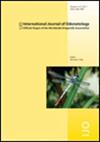Odonata飞行中的快速加速:高度倾斜和同相的机翼跳动
IF 1
4区 农林科学
Q3 ENTOMOLOGY
引用次数: 4
摘要
利用慢镜头分析了五种豆娘和四种蜻蜓在自然界自由飞行中的加速动作。在加速过程中,记录了划桨频率、划桨角度、划桨方向、翅膀倾斜角度以及前后翼的相位关系的变化。豆娘和蜻蜓表现出相似的行为。在快速加速中,可以看到两个机翼对的关系向同相划桨的转变,以及在与飞行方向相反的划桨方向上使用高度倾斜的机翼。慢速后向飞行采用相移划动,快速后向飞行则采用同相划动。慢速和快速向后飞行中的下行程比上行程快。当逃离青蛙时,蜻蜓表现出极端的飞行动作:所有的划水阶段都是同相的,指向青蛙的划水相位非常快且高度倾斜。比较和讨论了每冲程飞行距离、无量纲飞行速度和加速度。本文章由计算机程序翻译,如有差异,请以英文原文为准。
Rapid acceleration in Odonata flight: highly inclined and in-phase wing beating
Acceleration manoeuvres in free flight in nature of five damselfly (Zygoptera) and four dragonfly (Anisoptera) species were analysed by means of slow motion filming. Changes in stroke frequencies, stroke angles, stroke directions, angles of inclination of the wings, and the phase-relationship of fore- and hindwings were recorded during acceleration. Damselflies and dragonflies showed similar actions. In rapid acceleration, a shifting of the relationship of the two wing pairs to in-phase stroking and the use of highly inclined wings in the stroke direction opposite to the flight direction can be seen. Slow backward flight was done by phase-shifted stroking, fast backward flight by in-phase stroking. The downstrokes in slow and fast backward flight were quicker than the upstrokes. When fleeing from frogs, dragonflies show extreme flight action: all stroke phases were in-phase and the stroke phases directed toward the frog were very fast and highly inclined. Distances covered per stroke, non-dimensional flight velocities and acceleration are compared and discussed.
求助全文
通过发布文献求助,成功后即可免费获取论文全文。
去求助
来源期刊

International Journal of Odonatology
ENTOMOLOGY-
CiteScore
2.30
自引率
0.00%
发文量
15
审稿时长
>12 weeks
期刊介绍:
International Journal of Odonatology (IJO) is aimed at providing a publication outlet for the growing number of students of Odonata. It will address subjects such as the ecology, ethology, physiology, genetics, taxonomy, phylogeny and geographic distribution of species. Reviews will be by invitation, but authors who plan to write a review on a subject of interest to the journal are encouraged to contact the editor.
 求助内容:
求助内容: 应助结果提醒方式:
应助结果提醒方式:


